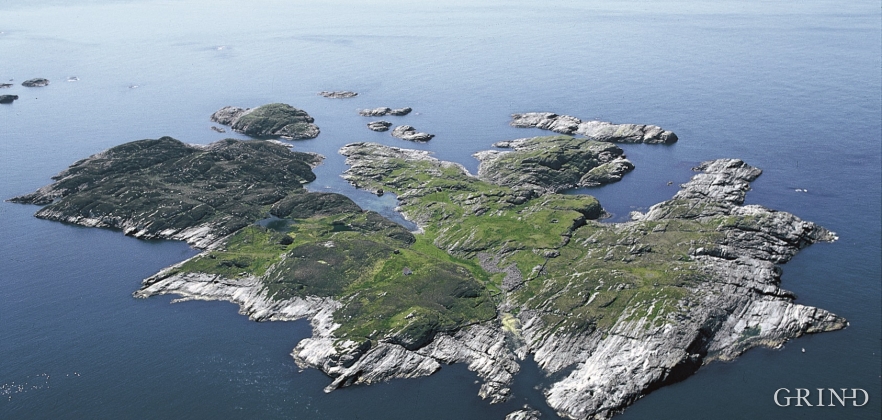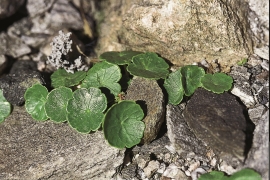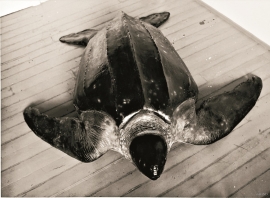Published: 05.08.2015 | Author: Stein Byrkjeland, Bjørn Moe, William Helland-Hansen
BOAT HARBOUR AND BIRD RESERVATION
Small boat folk in Hordaland know where Løno is. As do many seabirds. With the big ocean at its back and a wide, weather beaten strait ahead of it, Løno is one of Hordaland’s most isolated and exposed recreational areas. The islands west of Sotra are some of the county’s most stable nesting localities for seabirds.
The birds not only have property rights, they have also been clever at starting their nesting season on Løno before the small boat flotillas have been fixed up and made seaworthy after the winter. When the small boats do come out, there is a kind of competition for living space along the edge of the sea. The sea birds have the authorities on their side; in 1987 the southwesterly parts of Løno and some of the smaller outside islands came under protection as a nature preserve. In the protected zone, trespass is forbidden during the nesting season, from the 15th of April until the 1st of August.
Previously, the nature preserve had a nesting colony of Lesser Black-backed Gulls, Herring Gulls and Arctic Terns, and in addition, abundant populations of Great Black-backed Gull and Common Gulls. But, as on other bird reservations, the colonies change with time. The Herring Gull populations have remained stable, while the Great Black-backed Gulls have declined significantly. The tern populations are unstable. The biggest seabird colonies today are found outside of the reservation, after new establishments on Sengholmen and other small islets.
Parts of Løno have been purchased for use as a recreational area, administered by the Bergen and Omland Recreational Association. It is the good natural harbour that has made the island so popular. It lies in a small wedge shape, as if a wedge cut into the island. Løno is named after the wedge shape (“Lón” is the old Norwegian word name for “deep pool”).
Self-supporting at the mouth of the sea
There were permanent residents on Løno during the period from 1845-1951. At most, there were six farms and 50 inhabitants, and they had their own school. The soil was not easy to work, and the farms were small and difficult to run. But, the coastal farmers knew how to use the resources they had; these island folk were self-supporting in their supply of potatoes, vegetables and food for their animals. One can find remains of old homesteads and old stone walls from this time of settlement by the sea.
There are still sheep roaming the moors on Løno, and in this way, a bit of the old culture is kept alive. The free-grazing sheep are “permanent residents; they find vegetation that is suitable for grazing both in summer and winter. In the summer, the animals prefer to wander the grassy fields north and west on Løno, while the southeast side, which is covered in heather moors, is their main grazing area in winter. The heather moors are in a suitable condition for them, without bushes or thicket. Several beach plants grow on the moors on the inside of the island, preferably in small ponds of brackish water.
A belt with stone blocks to the inside of the island is believed to have been deposited about 15 000 years ago with the last glacier that reached this far west. The blocks have since been washed back and forth by the sea, which at that time was about 30 metres higher than today. In modern times the blocks have been used for building stone walls.
Common pennywort is a small, distinctive plant. In Norway, it is found along the outer coast, from Hvaler to Hordaland (northern boundary to Fedje). It is abundant on certain islands in outer Hordaland. It is especially exuberant on Løno.
Leatherback turtle
In the Natural History Collections of the Bergen Museum, you can see two stuffed leather-backed turtles, that were captured at Løno and west of Øygarden in the late summer of 1856. This special and threatened reptile lives in the tropics, but occasionally follows the Gulf Stream and then can make its way to the Norwegian Coast. Since 1956, 14 leatherbacked turtles have been discovered in Norwegian waters. Swimming jellyfish are its favourite food, and many of those get devoured when you think that the biggest of all turtles when full grown normally weighs over 300 kilos, and the biggest known over 900 kilos. We do not know if those leatherbacks that make it to our coast find their way back to the tropics to lay their eggs. The cold waters up here in any case do not seem to pose a problem for these turtles.
- Byrkjeland, S. 1999. Status for hekkande sjøfugl i Hordaland 1980–1998. Fylkesmannen i Hordaland,MVA-rapport 2/1999.







